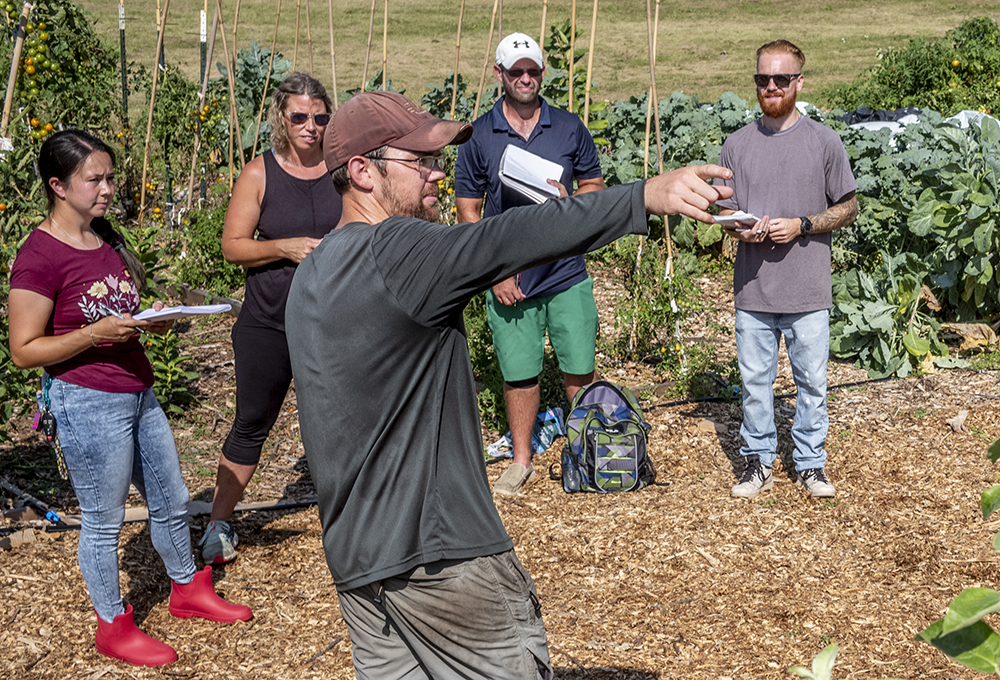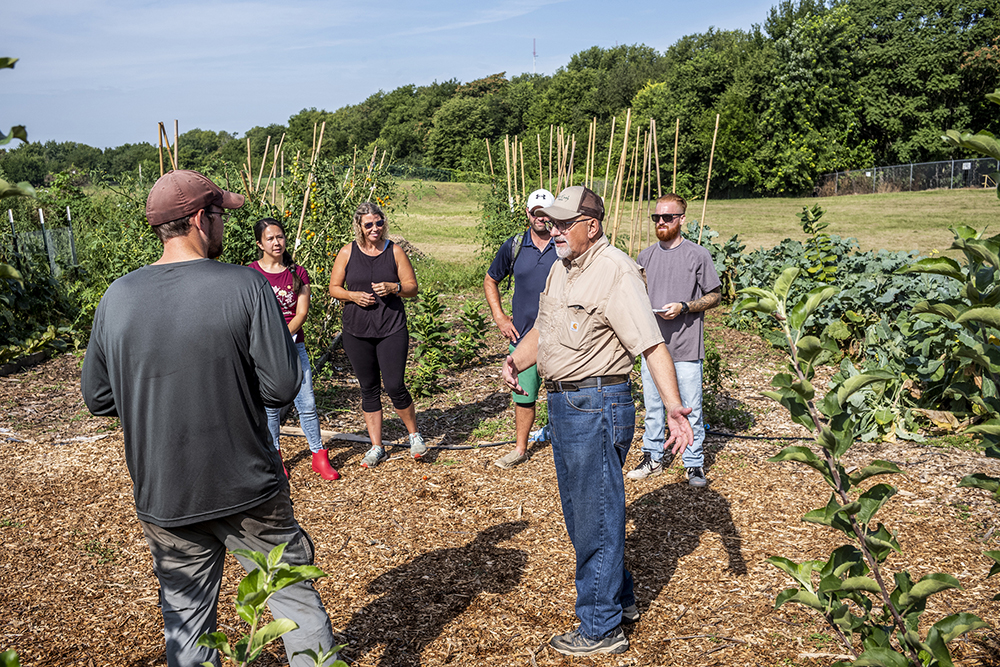
Caleb Phillips, manager of Sunnyside Community Garden & Food Forest, speaks with Dave Bishop’s class on “Principles of Regenerative Ag” at Heartland Community College in Bloomington. The operation provides food for families living nearby and paid part-time internship jobs for nearby students. (PHOTO BY DAVID ZALAZNIK)
Here’s the question: “Why has the industrial food system, after decades of producing massive quantities of food – 40% of which goes to waste – failed to eliminate hunger in the world? And not just in ‘poor countries,’ but in communities like this one here in America.” Your answer in one sentence please.
Here is how I answered the question: “The industrial food system is based on corporate ownership, and corporations are focused on profit before the wellbeing of mankind.”
Here’s how the course instructor Dave Bishop responded to my answer: “I can accept that answer! Mine was, ‘because it’s not designed to do that.’”
Bishop is part of a multi-generational organic farm family in Central Illinois. He’s also now a college instructor at Heartland Community College in Normal, Ill., teaching “Principles of Regenerative Ag.”
On a hot morning in late August, Bishop met with his students at Sunnyside Community Garden & Food Forest in Bloomington.
Here is the question posed to the class prior to that meeting:
“How exactly to do you address hunger in underserved communities? Just pass out SNAP benefits? Does that ensure that everyone (especially children) will have access to fresh, healthy food? Is donating food – like leftovers from the farmers market or contributions from a food bank – the answer? It would seem if that were enough, there would be no hungry or food insecure people.
Or is the issue more complicated? Caleb Phillips operates Sunnyside and has some thoughts to offer on addressing hunger.”
Phillips has a Ph.D. in theoretical mathematics and is farm manager at Sunnyside.
When Sunnyside started in 2016, the west side of Bloomington was a food desert, Phillips told the class.
The operation is about one acre next to a public housing project. It didn’t take Phillips long to conclude the nonprofit had to provide cooking classes as well as food in order to accomplish its mission of providing fresh fruits and vegetables to the low-income households in the area.
This year, the operation provided food for 400 families and recently expanded to supply several restaurants in town. In return, restaurants supply Sunnyside with a steady income stream so it can pay stipends to kids from the nearby housing project to intern at the farm. Volume to restaurants has increased to the point that income from one week this year exceeds the income of all of last year.
Phillips has worked in orphanages in China, Brazil and Thailand.
“There are 140 million orphans in the world,” he told the class, “Kids are in dire crisis worldwide. And food relief is needed in the U.S. as well.”
Bishop told the class “We are the richest country in the world yet hunger and malnutrition here is incredible and the numbers are growing. Do we continue to throw money at the problem? What are we missing?”

Caleb Phillips, left, listens as Dave Bishop discusses how the current system of industrial agriculture is not geared toward feeding hungry people. (PHOTO BY DAVID ZALAZNIK)
Part of the problem, according to Bishop, is poor nutritional value in much of the food grown on industrial farms reliant on chemicals. He and Phillips said food grown in organic soil with organic inputs is nutrient dense.
Phillips added that when he was working in Thailand, government programs provided rice, not food like the diverse produce grown on small organic farms.
Even in the United States, many organizations providing food aid supply boxes of cereal, mac and cheese and frozen pizza.
Sunnyside is based on the belief its nutrient-dense produce is essential to fight hunger and malnutrition. The farm grows tomatoes, peppers, collards, kale, cucumbers, berries, melons, sweet corn and green beans among more. Fruit trees will soon add to that yield.
Phillips questions the ethics of an industrial food system geared to providing more food that has less nutrition, depletes soil, harms butterflies and relies on poorly paid, exploited farm workers.
Bishop told students that cheap industrial food comes with the hidden costs of chronic diseases like high blood pressure, diabetes and obesity. Phillips added that when the U.S. military can’t meet recruitment goals because of obesity and other health problems, it becomes clear nutritional food is integral to national security.
Cody Lyons is one of the first four students to enroll in Bishop’s class. His goal is to operate a community farm like Sunnyside.
“I want my voice out there,” he said. “I want to help resolve some of these issues.”
Despite massive financial aid, global hunger is a growing problem according to the United Nations:
In 2020, more than 2.3 billion people (30% of the global population) lacked year-round access to food –– an increase in one year that exceeds all of the previous five years combined.
If recent trends continue, by 2030, 840 million people will be hungry –– 9.8% of the global population.
Children pay the highest price with over 149 million children under age 5 stunted. More than 45 million are too thin. Nearly 39 million are overweight.
According to the USDA, 38 million people in America experienced hunger in 2020 –– including 12 million children.
Research shows an association between food insecurity and delayed development in young children; risk of chronic illnesses like asthma and anemia; and behavioral problems like hyperactivity, anxiety and aggression in school-age children.
